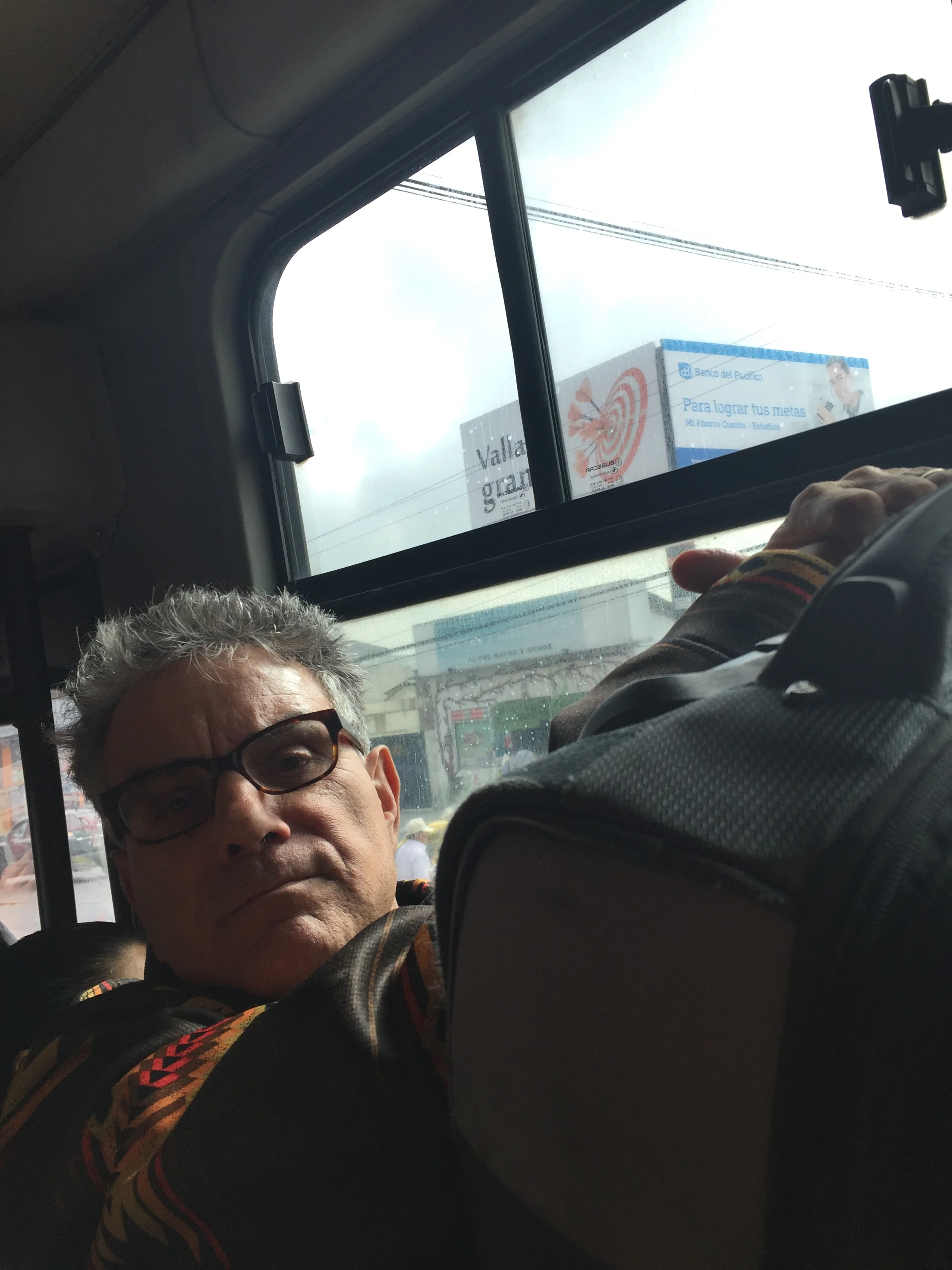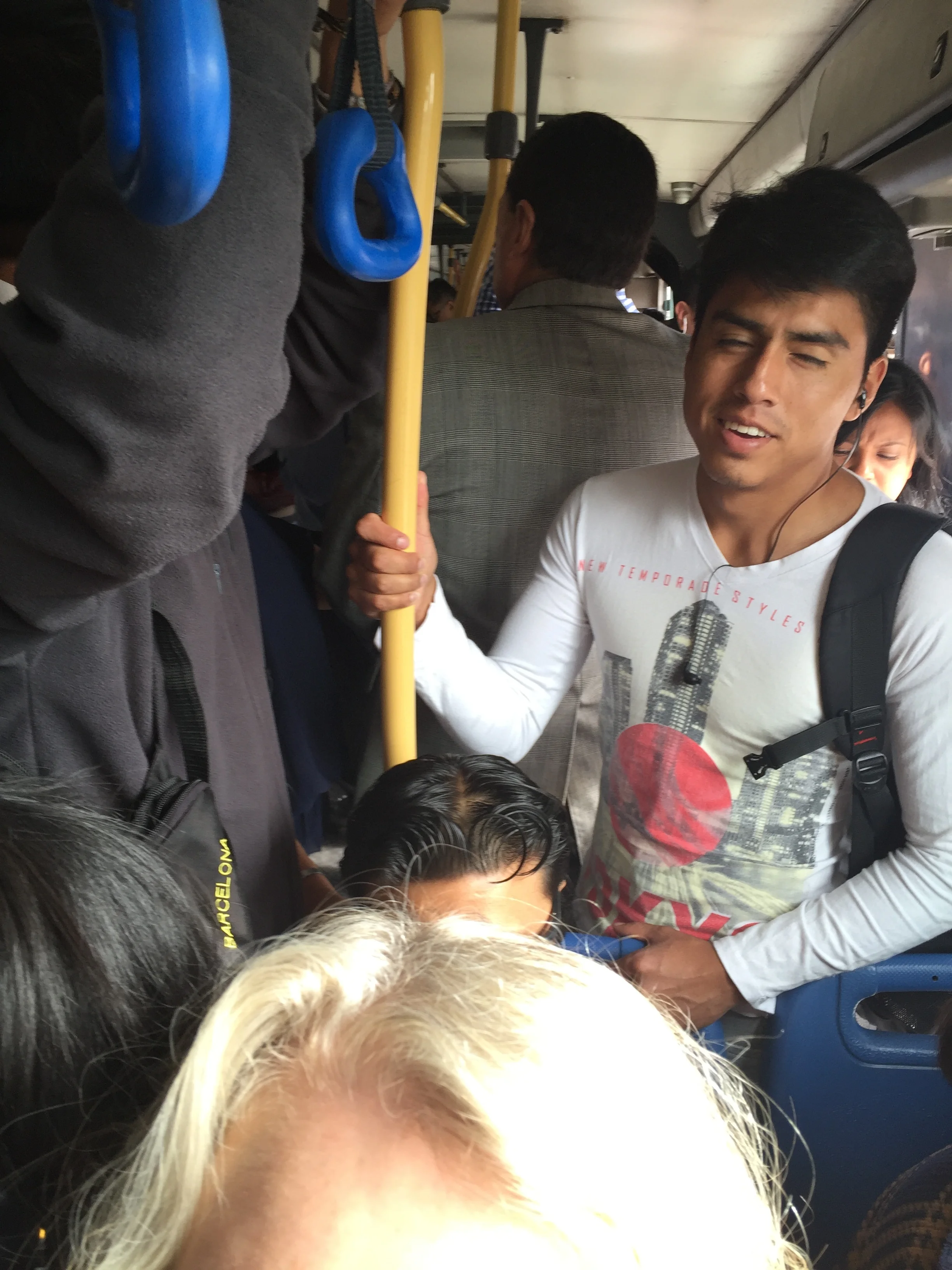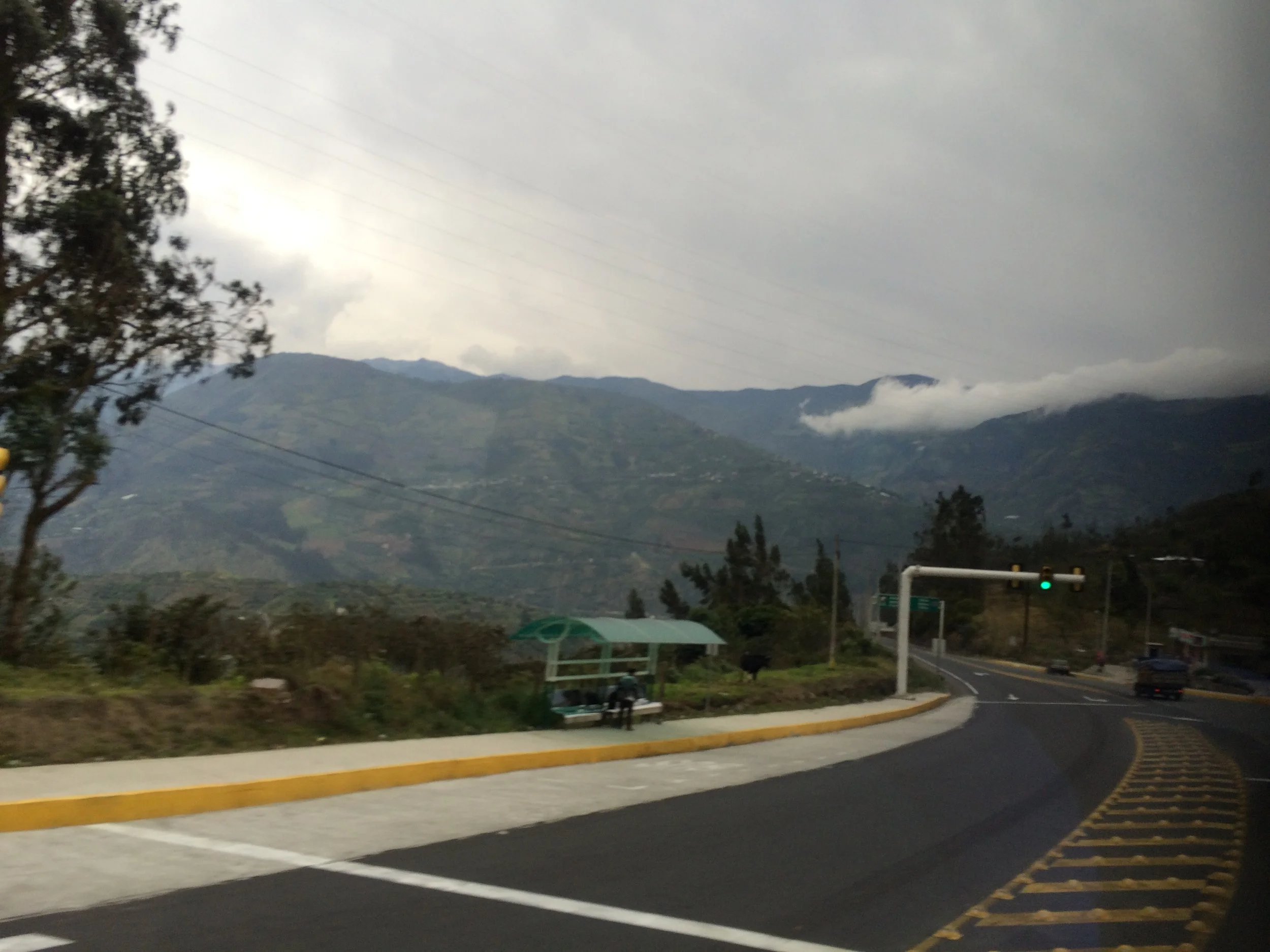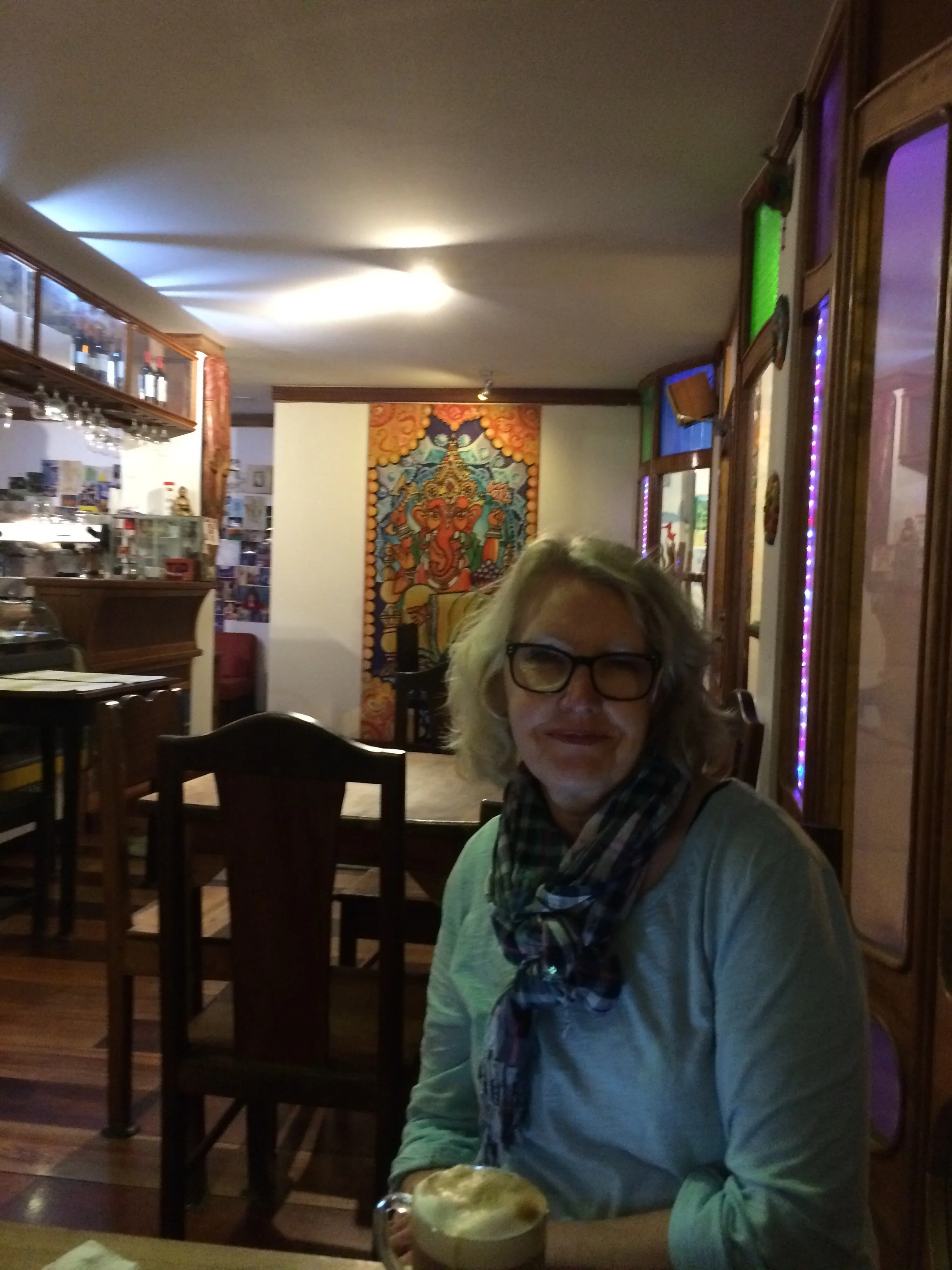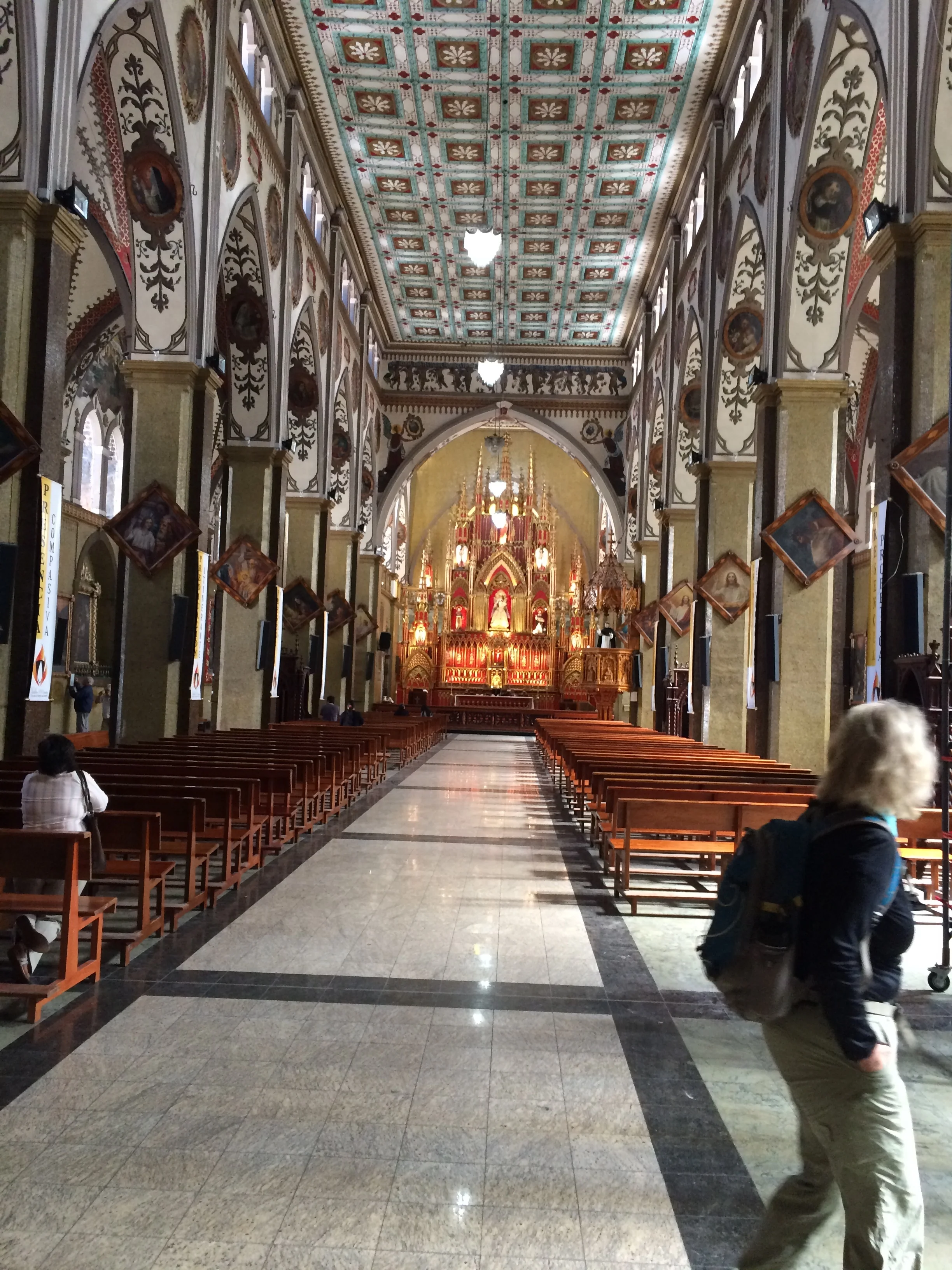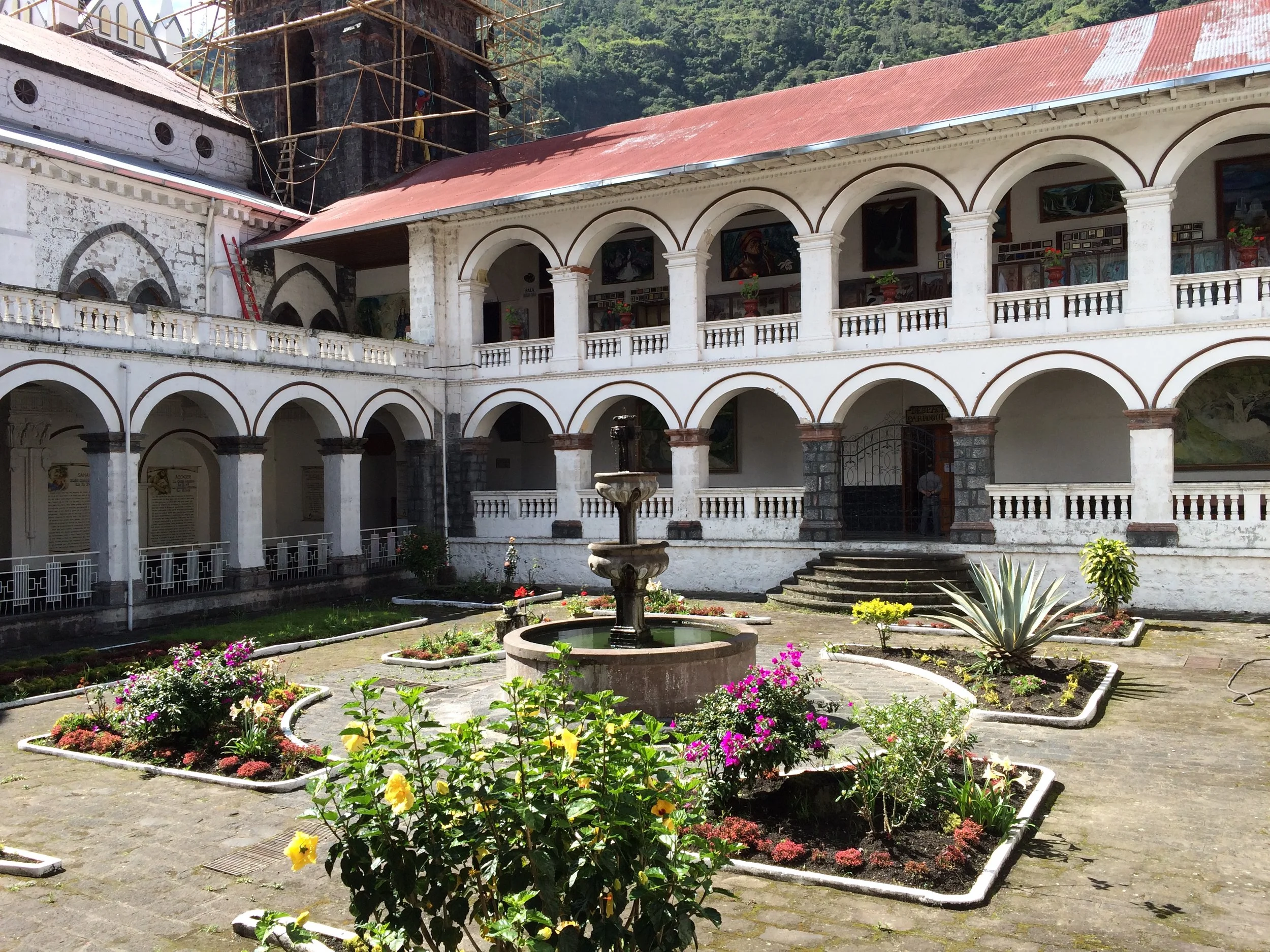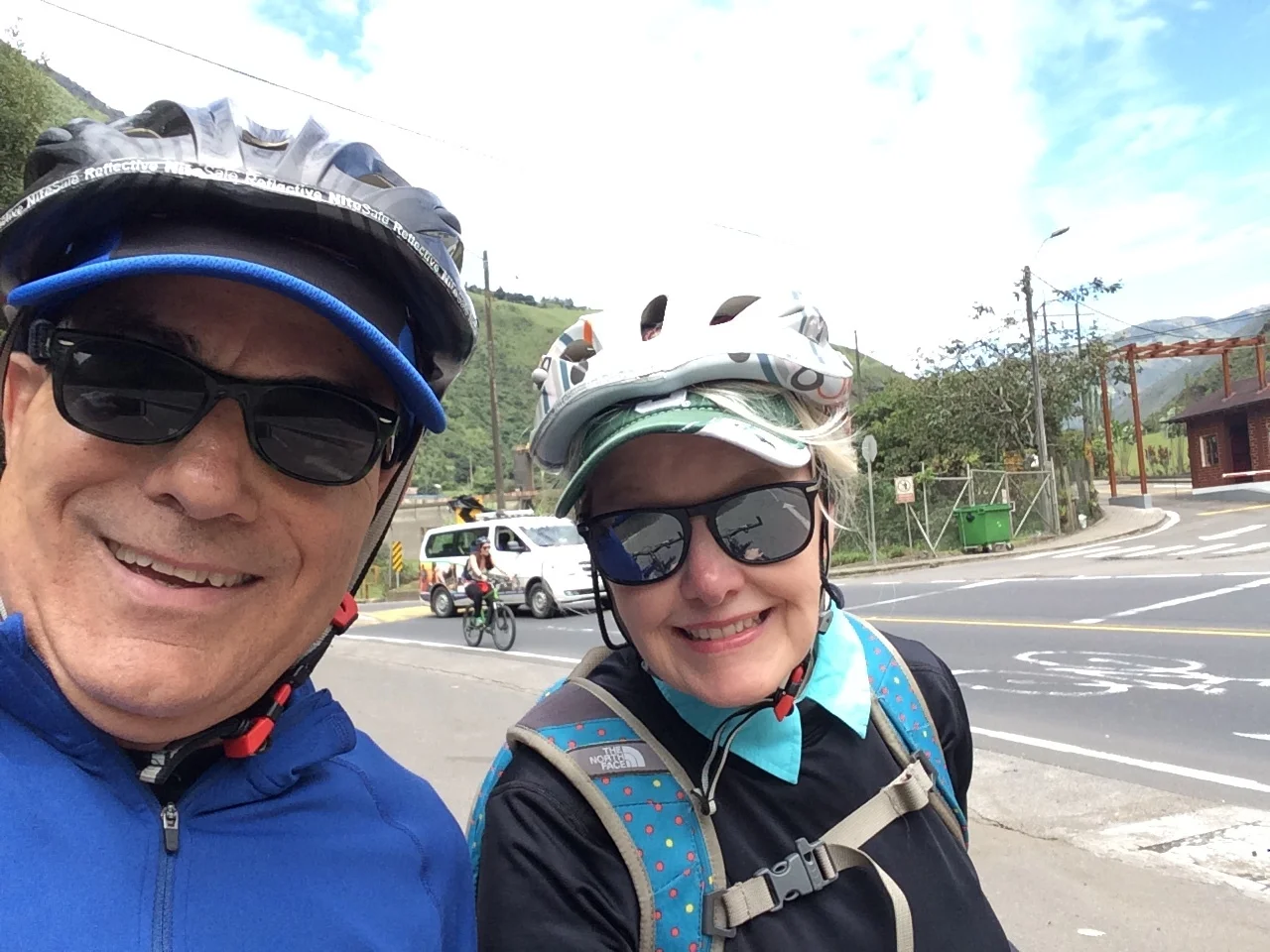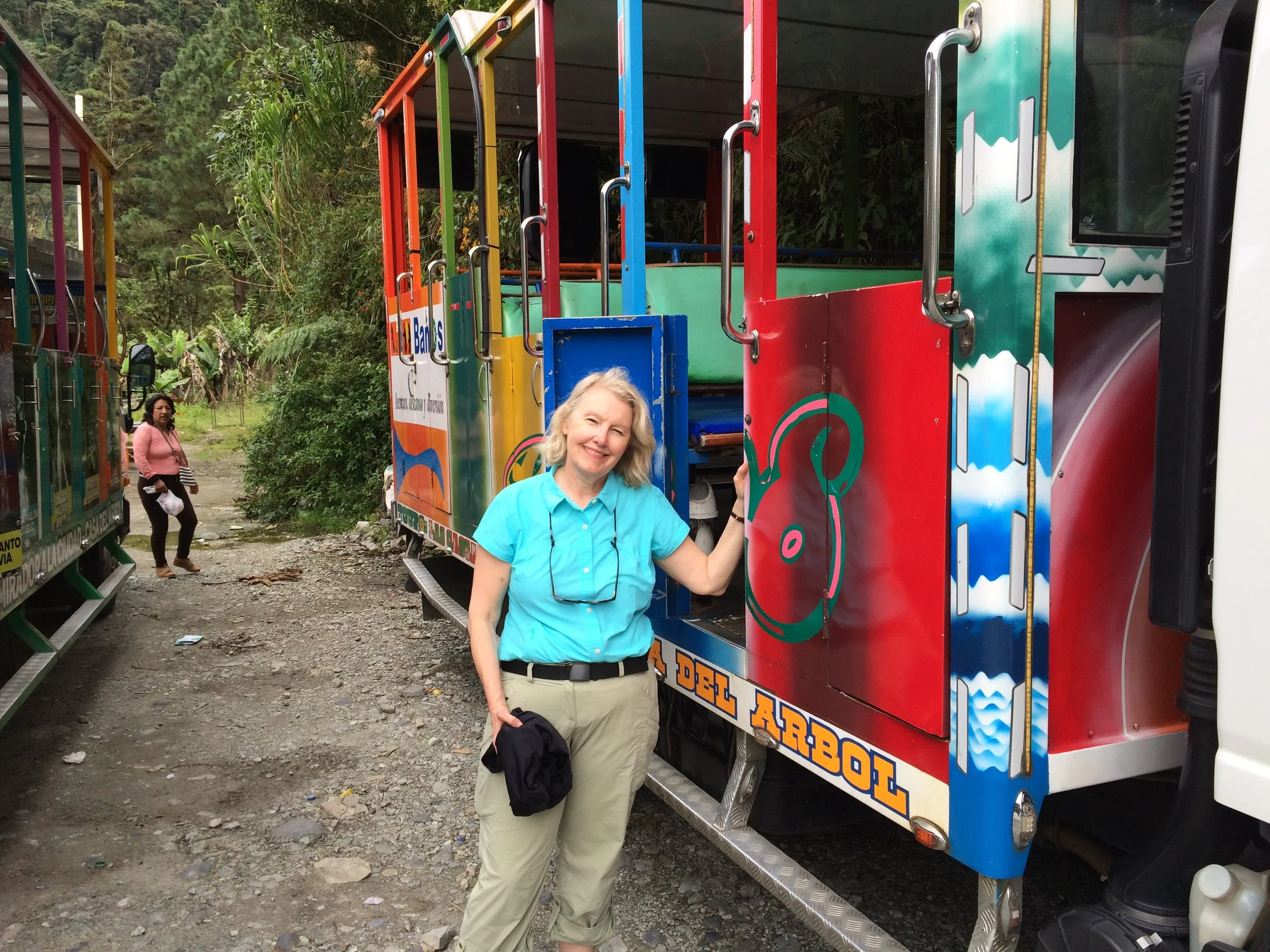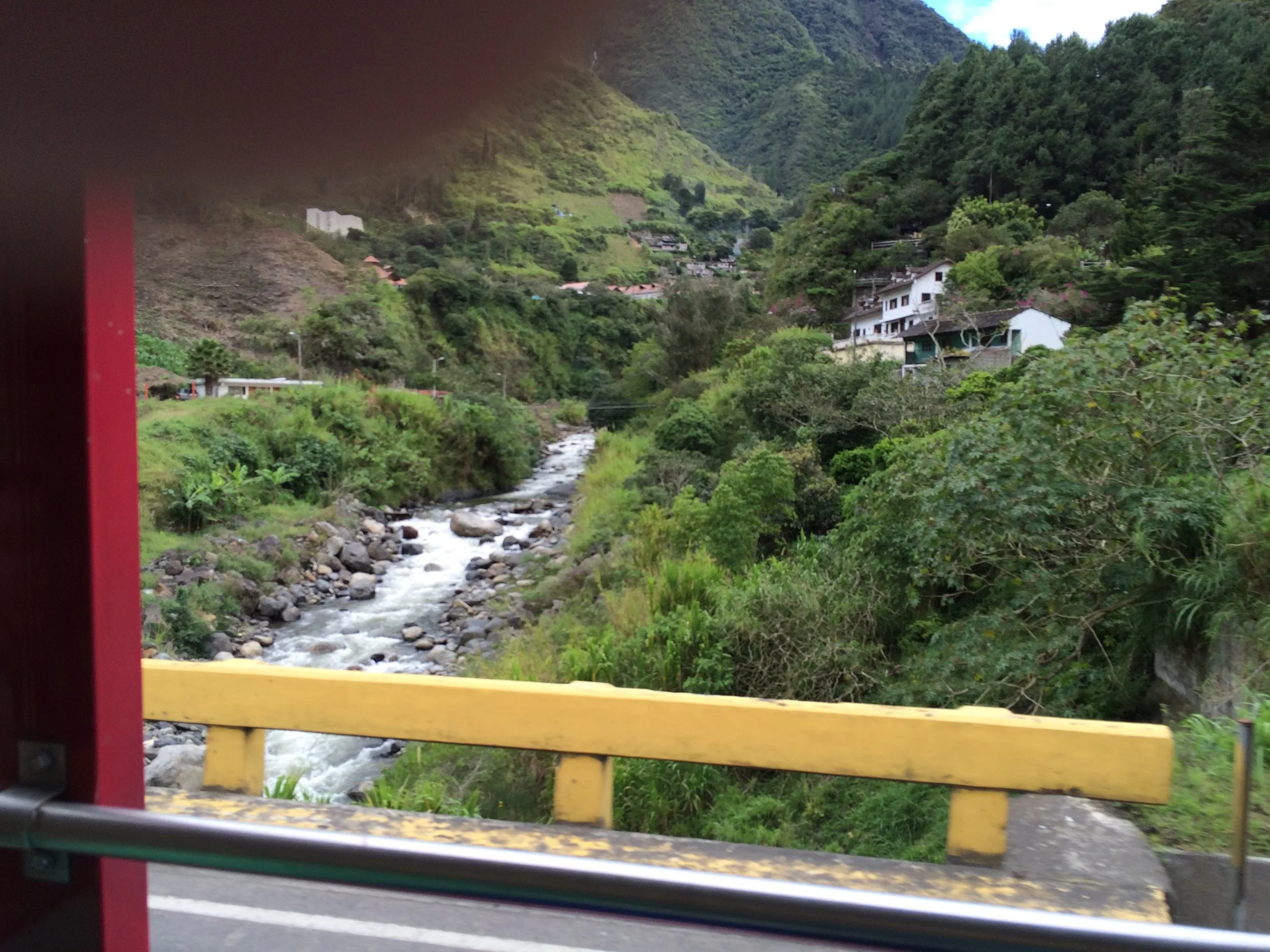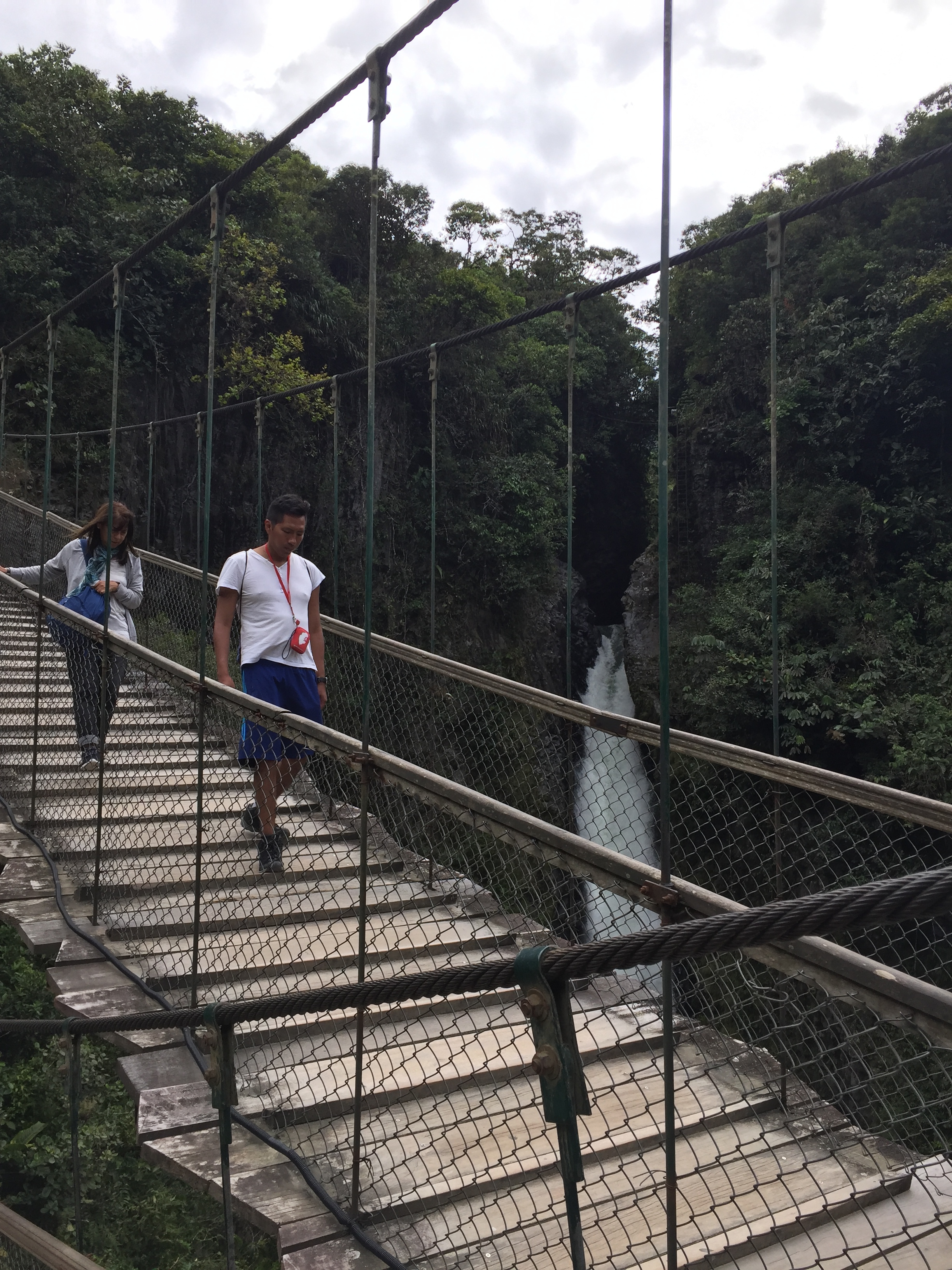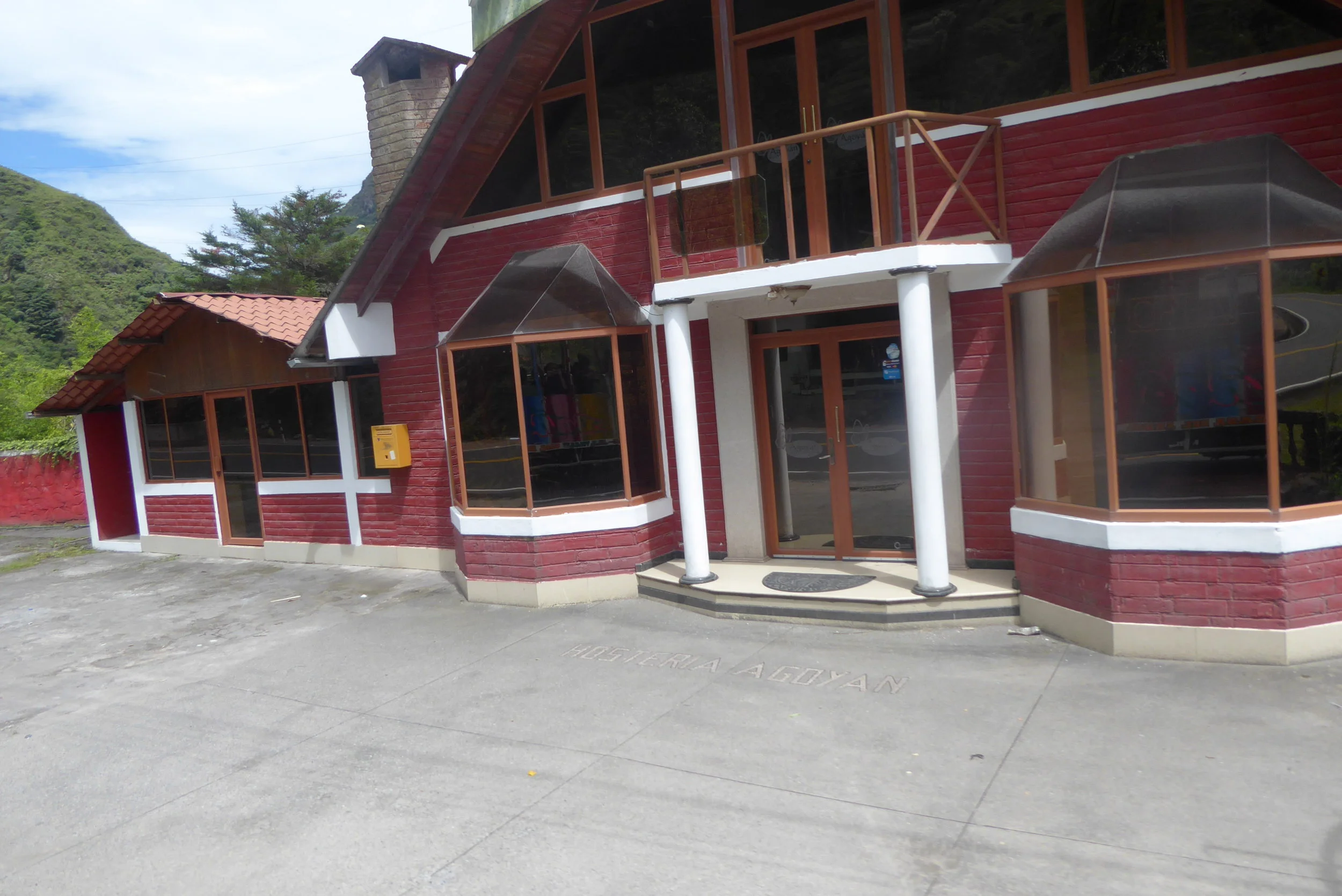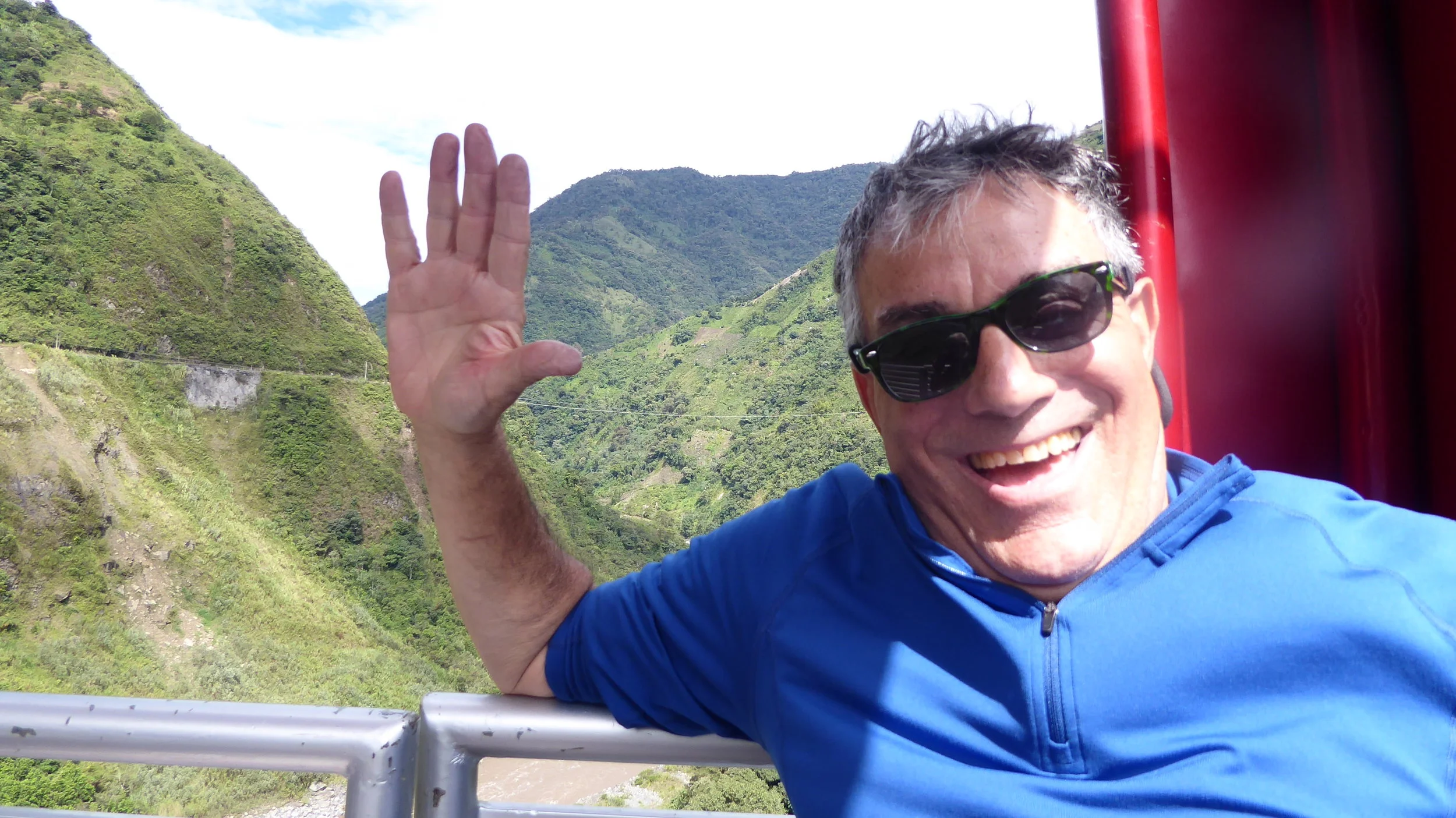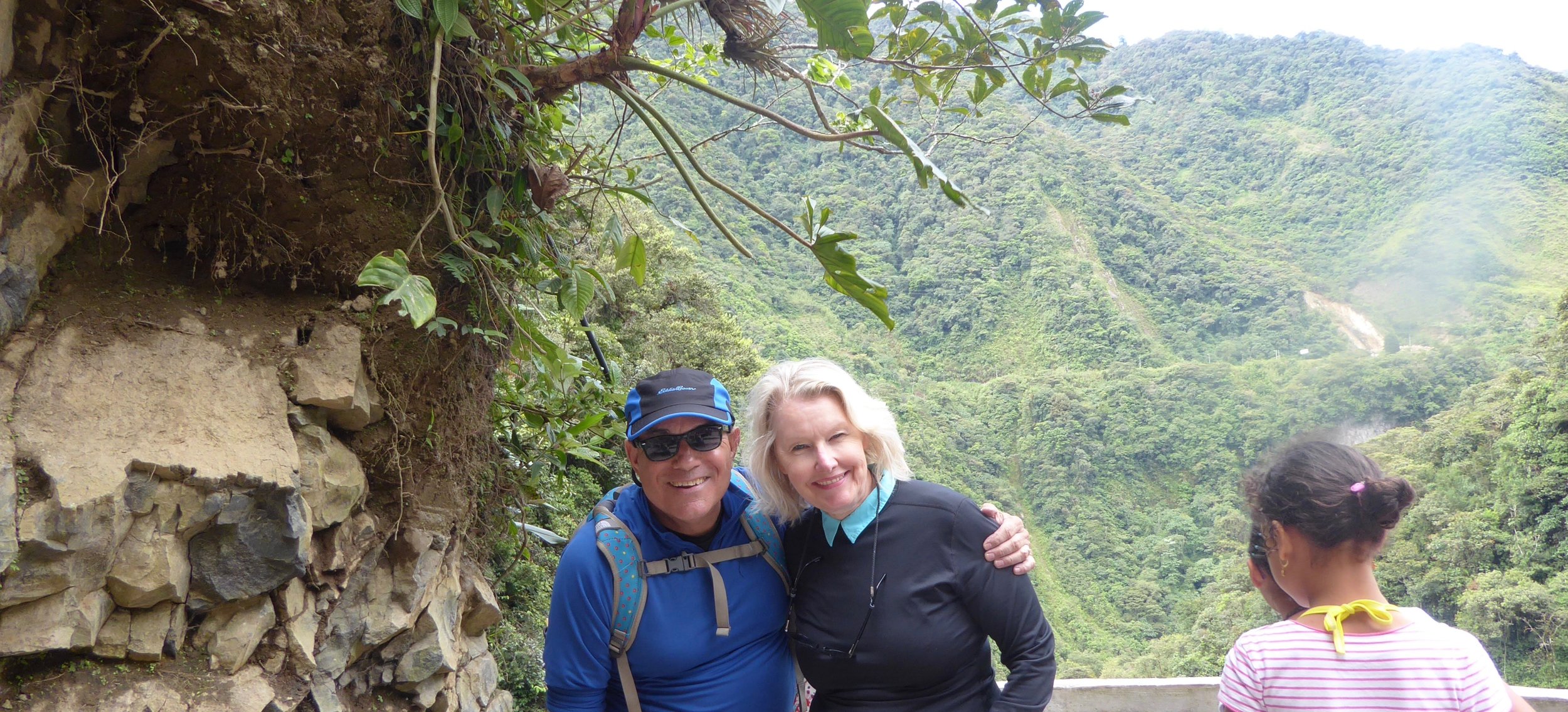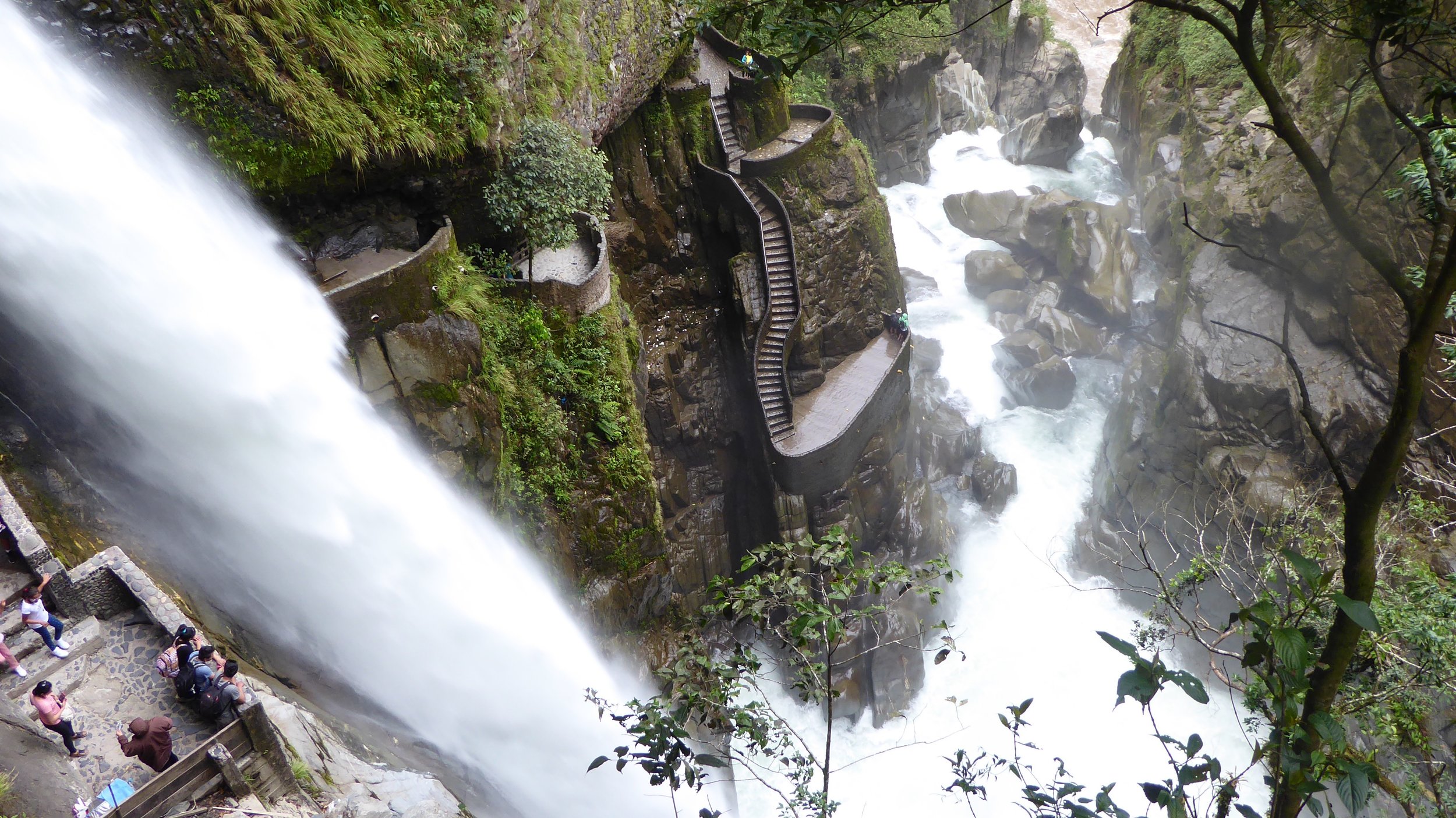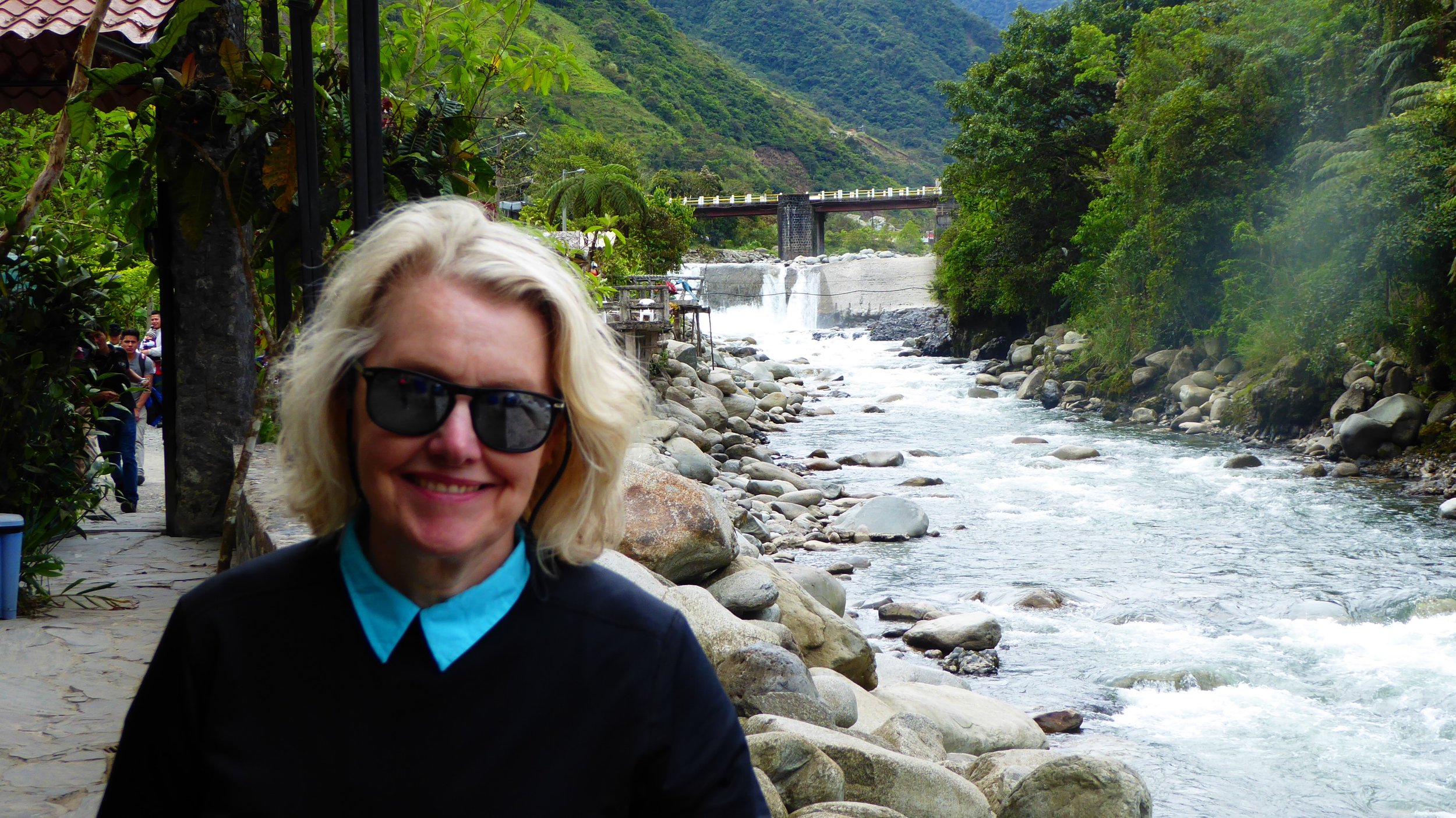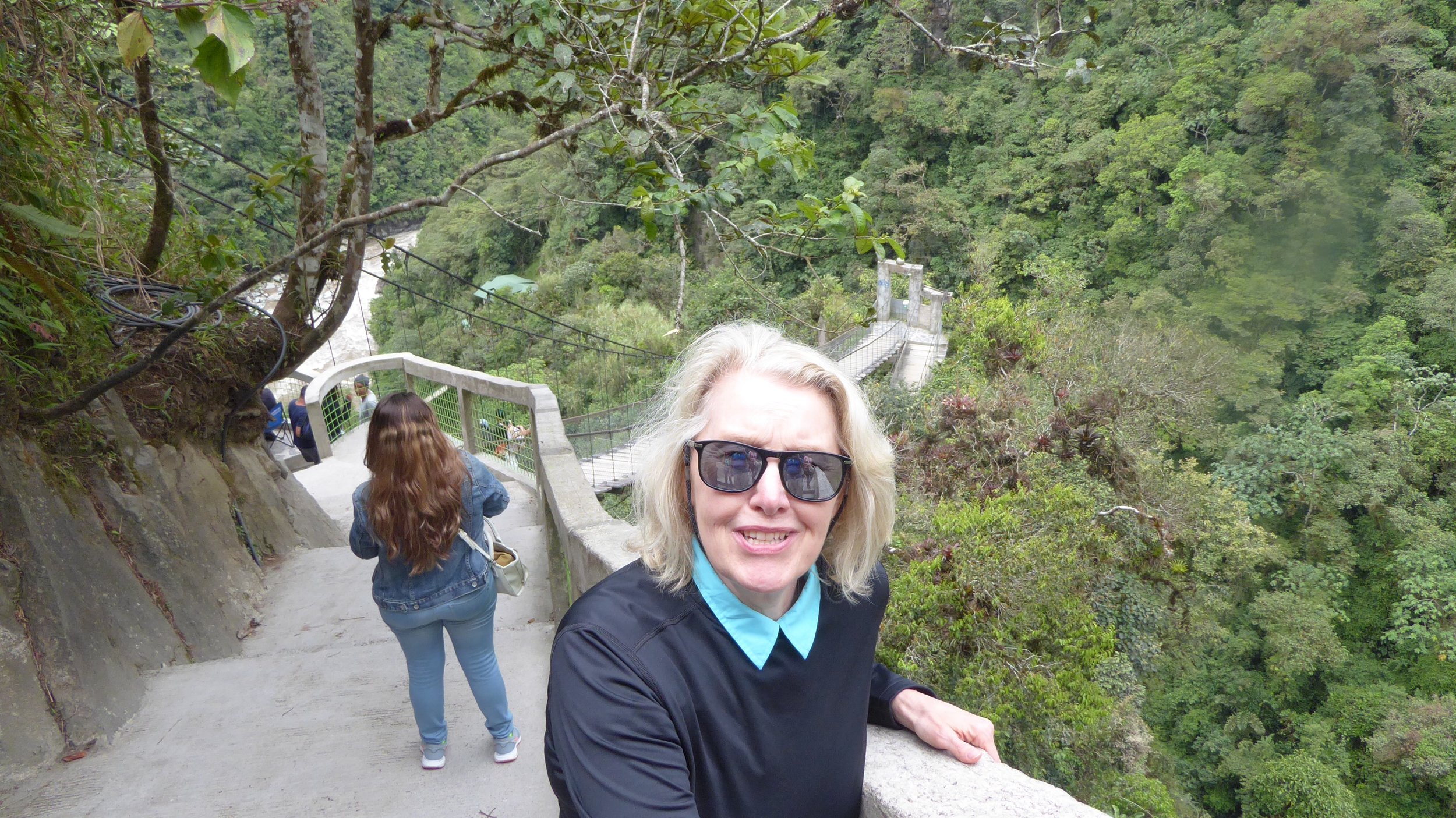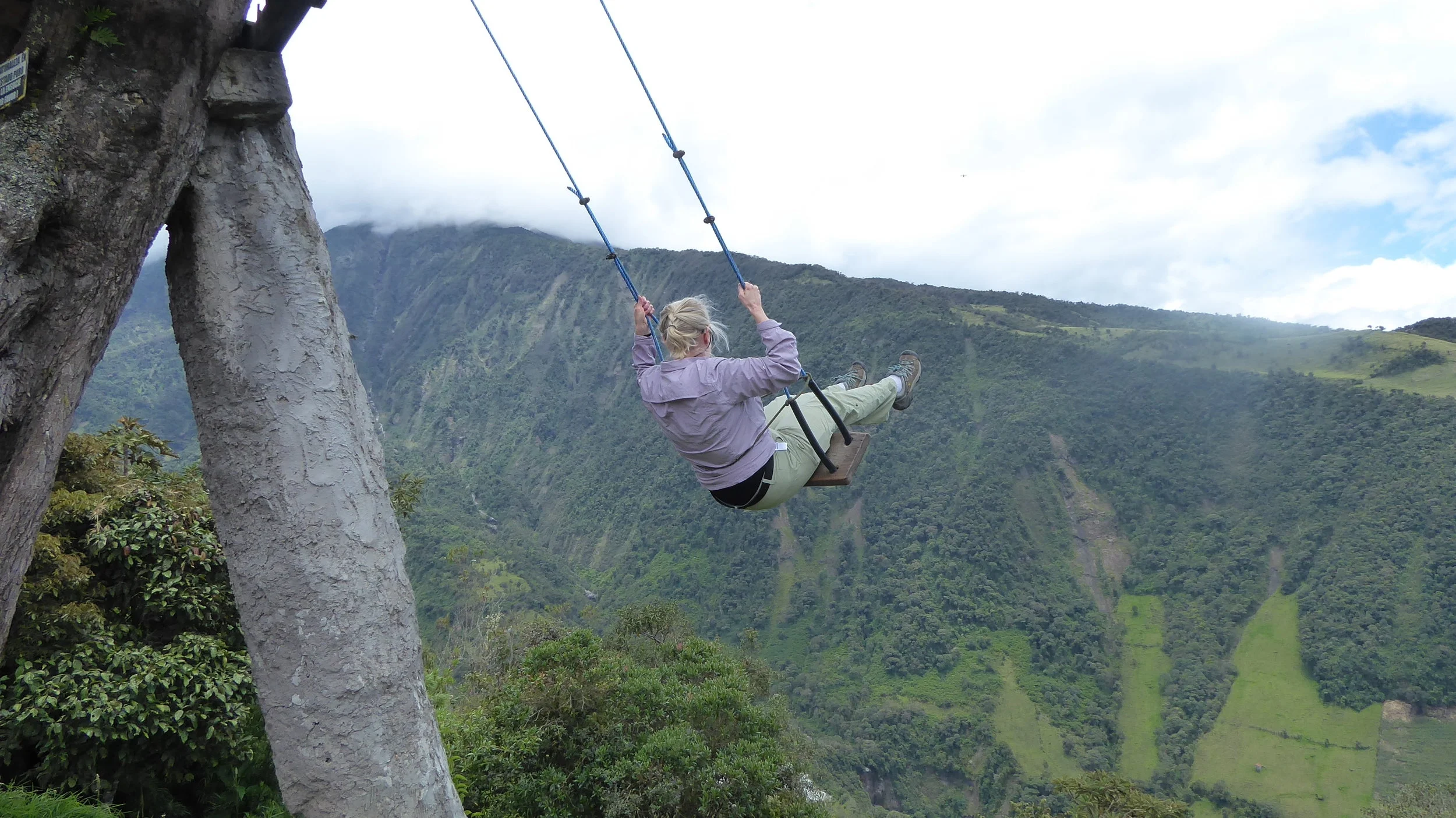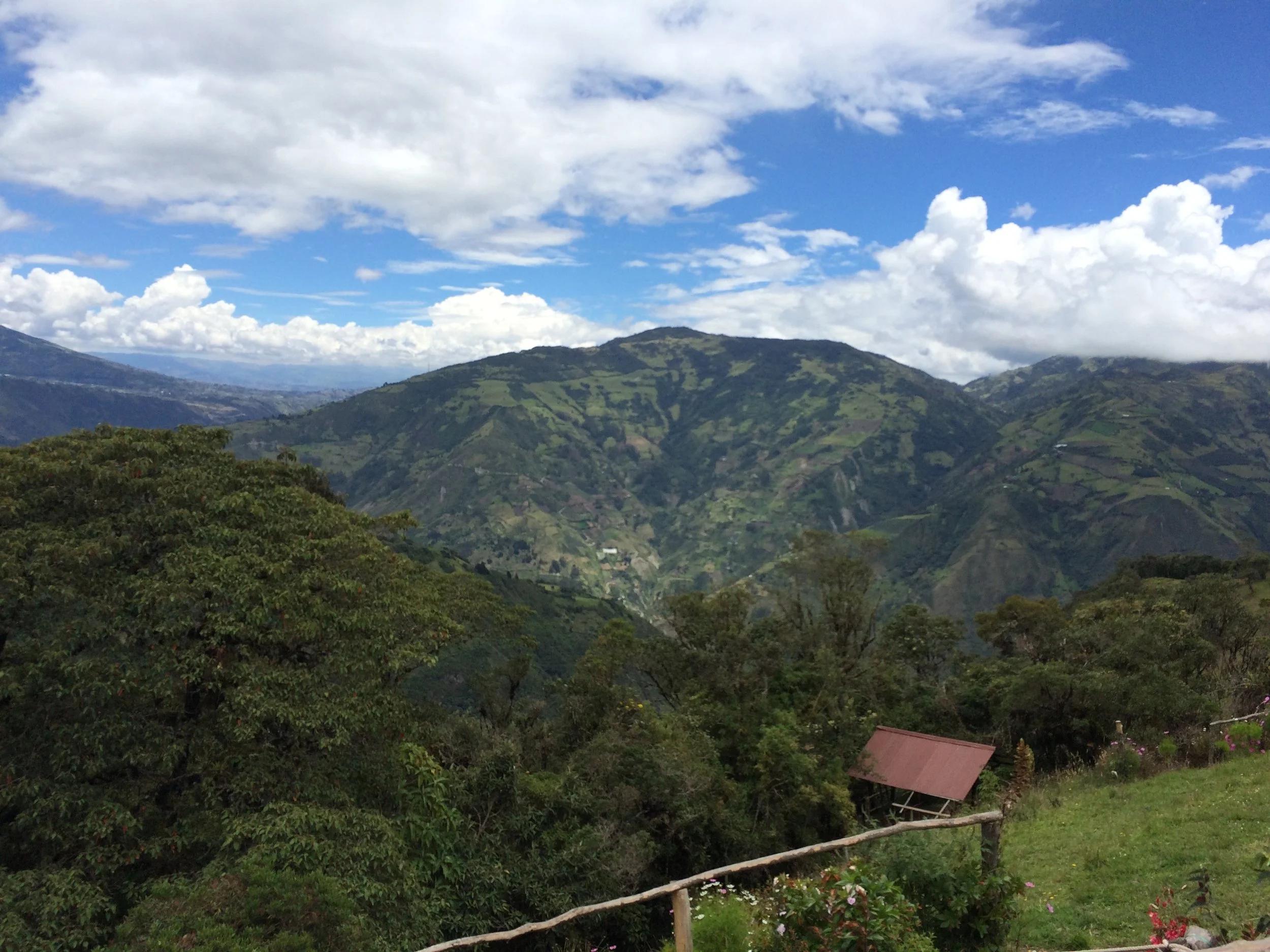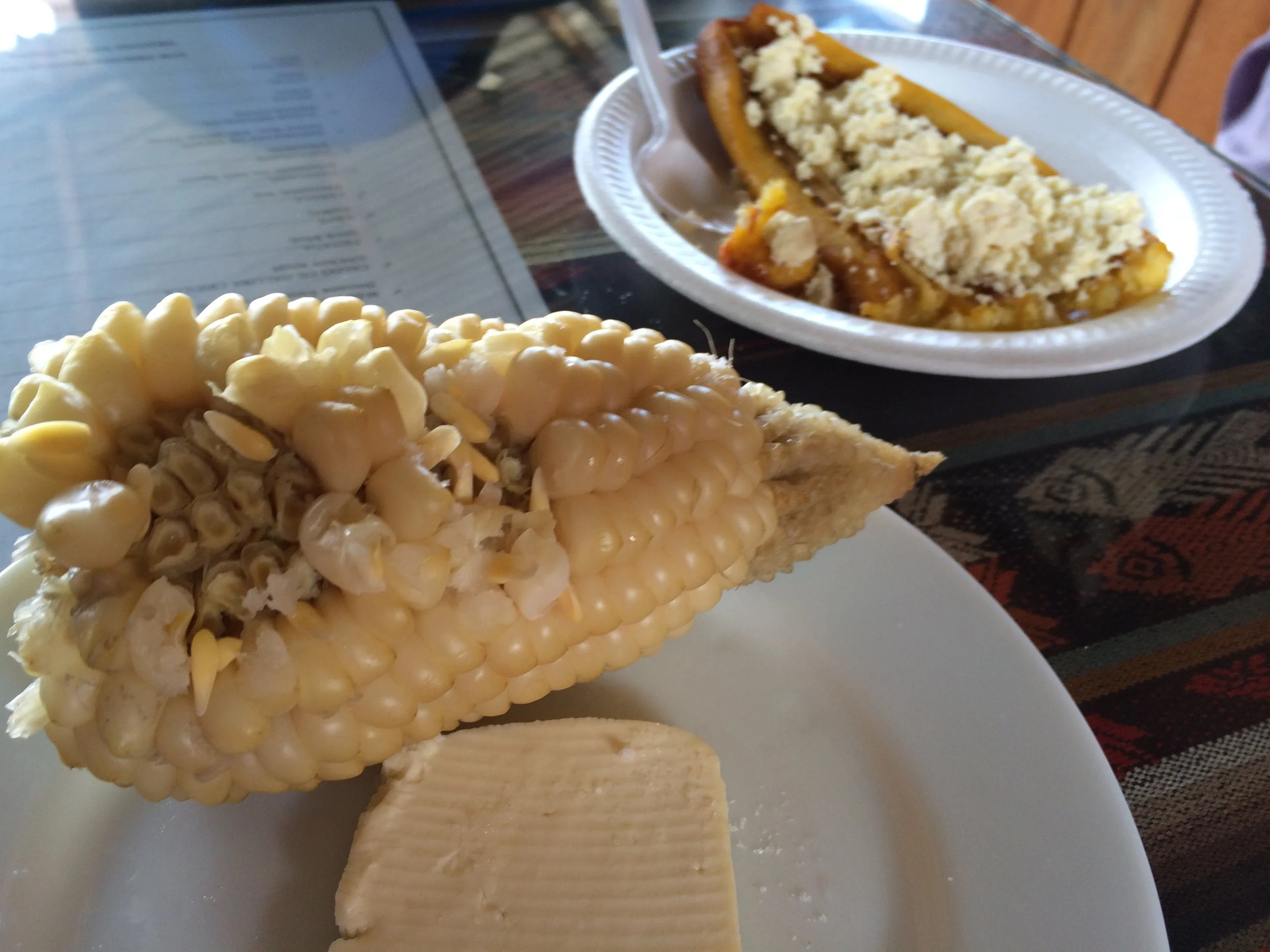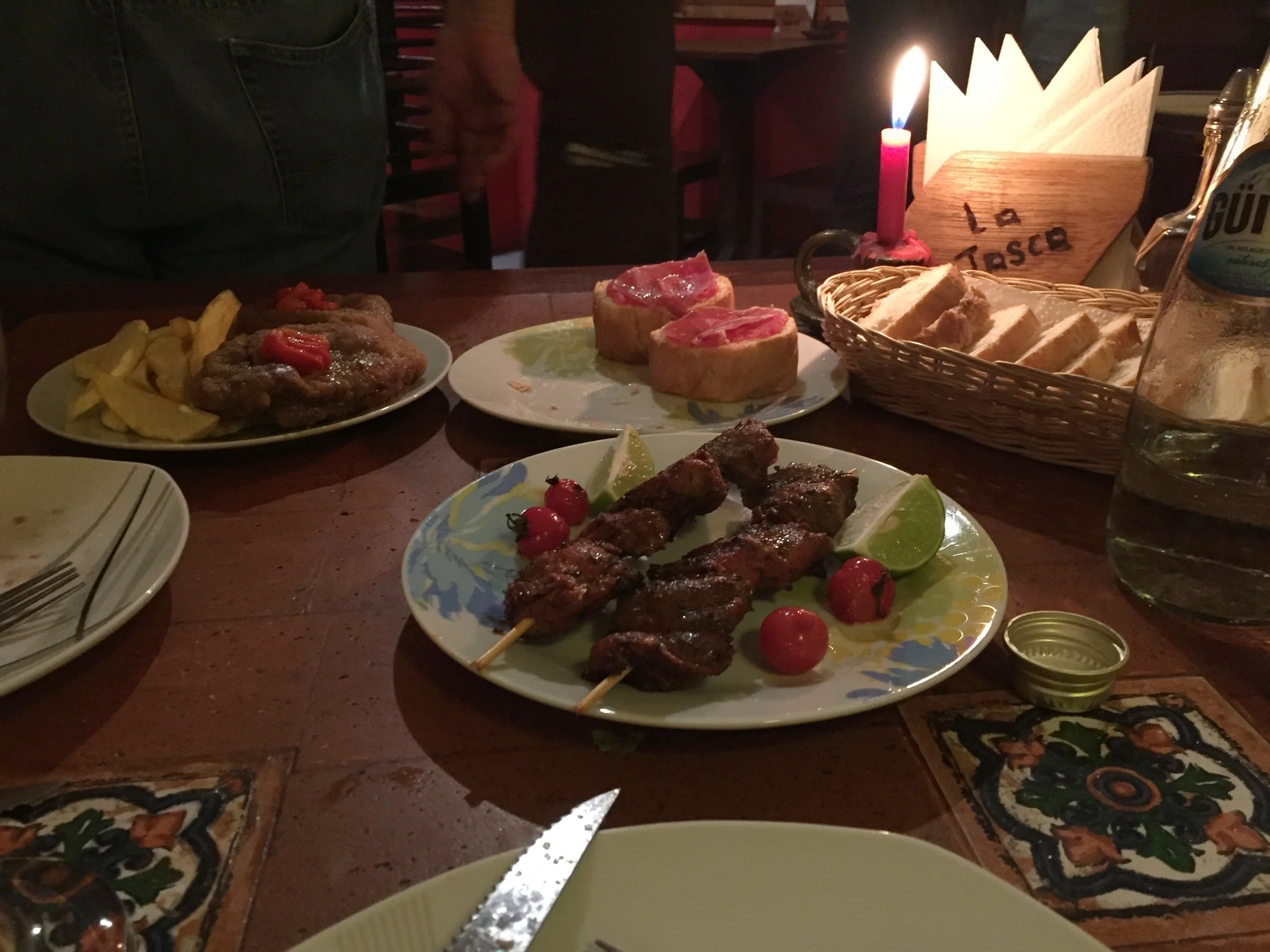Banos (pop. 15000); is a very popular tourist destination. Some of our traveling friends thought it too touristy, but I liked the town. We woke up in Mindo at 5:00 am to catch the earliest bus. We walked a few blocks to the station by 6:00 am, bought our tickets, had coffee at the only open restaurant in town at that hour, and loaded up prior to the 6:30 departure. Buses are always on time here. The attendant reminded us to keep our backpacks close, with bigger luggage placed in under storage. We met a nice French couple. Typically, we found that even the bus stations do not have change for larger bills, i.e. $20’s, and this was the dilemma this couple faced. She asked “Polle vue Francais”, I said “No”, I can’t even spell that phrase. We suggested she go to the same coffee shop which she did not know was open. She knew English and got her change and later she and her fiancé’ became friendly, helpful, and traveling companions. She spoke Spanish too.
We left Mindo in a nice travel bus; again no chickens, but had to transfer buses once we returned to Quito’s Ofelia Depot in order to get to the real big bus terminal in Quemba, in city south. This is where the fun began. Janet offered/suggested we share a taxi. They said OK, but seemed hesitant and hinted to taking a connecting local bus. I picked up on the que and we agreed—we would take the bus for $25 cents per person. Trying to get on board a local bus and get a narrow seat with our suitcases and backpack is crazy; no room to maneuver. The French girl chuckled: “ You want me to take your picture”? I agreed this was comical. See pictures above. A little later the bus cleared and I stood up conversing with the guy, It turns out The airline lost the girl’s luggage, forcing her to buy piece meal items. After 5 days, they were exasperated since they were carrying very expensive mountaining equipment. I think they wanted to conserve money in case they had to replace more equipment. We hope it works out for them. We got to Quemba station and parted company—yet another great experience with fellow travelers.
Janet and I got on the bus to Banos. It left right on time for our 2 ½ hour trip. This is not a city bus, but it can be described as local. We stop at various ”Parada” for extra passengers and often uniformed school age children. This is common everywhere. All these buses also allow vendors on the bus for 5 minutes to sell food and drink; vendors get on at one stop and get off at the next several stops—and I guess they walk back or cross the street for the opposite direction bus. Janet has noted: “Thisreally the ultimate fast food industry supply chain. Food, food, food is always at hand and available in buses and on every street corner. I want to make it clear that the vendors are not in your face or harassing—these are sellers. A simple “no” or wave off, or ignore, will do nicely. Of course if you want something, it is a handy system. On the buses they sell mostly cookies, but on the streets I’ve observed that you get small amounts of fish, pork, beef, chicken, or Guinee pigs, mixed with vegetables and rice or bananas. This seems from my limited experience to be a vegetarian friendly society.
We arrived at Banos. Took a quick walk to the phone store to get new sim card and minutes; now we can call within Ecuador. Then went to the Farmacia for “stamps” and on a short walk toCasa La Real. This is a nice town. If “touristy” means very little graffiti and many restaurant, bars, and adventure outfitters, then I’m all for it. The Casa La Real Hostel is built in the traditional Ecuador style. It is a little tired in its décor, but the view from our balcony is worth a million. We see a large green mountain face in close proximity with a lengthy waterfall flowing from the peak down to street level. It is lite up for evening viewing. Our proprietor and assistant are very attentive, make wonderful “North Americano” breakfasts, with eggs, toast, fresh squeezed juices, and strong Ecuadorian coffee --with or without la leche. I knew I really liked the place, despite décor, when I put my face in the pillow and it smelled of fresh laundry.
Up early in the morning we toured the town and visited a really nice local church, then we were off for our first bike ride. The plan was to rent bikes and ride to see 5 waterfalls, then take the bus back, total trip is 17 km. It really felt good to be back on bikes and out of the stinky buses. But at 10 km, as I was peddling behind Frank I could see the chain dangling. Darn, after several inspections it was clear that the chain was bent and our peddling was over. We took the local bus back to the town and bike shop and opted to scrap the bike trip and back to the bus!! While we waited for the local tourist bus, we wandered into a small café for lunch and had our best meal yet, our first empanadas. After ordering we watched our young hostess make them from scratch starting with rolling the dough, they were pure heaven and was just what we needed after the bike meltdown.
Even in a bus the waterfalls were outstanding, we were the only non-Spanish speakers on the bus and the guide spoke no English but the beauty did not need any explaination. We also we took a 4 person gondola zip-line across the wide ravine of the river. What was most amazing was the stop at a park where we walked down a bazillion stone steps, crossed several rope bridges, and reached the bottom and went behind the most magnificent waterfall—much larger than any we had approached before. Of course, we made some friends. Three Ecuadorians, one who had studied in the US, where on the trip. When they wanted to zip line they asked us to watch their belongings. I felt good about that.
Casa La Real is near 2 of the 3 hot spring bath houses, so after our long day we opted to give it a go. You wear a swim suit and must rent a shower cap (unless you carry one around). We changed and then walked into a large pool which was heated by the springs. Several local women complained to the attendant that the water was too frio—turn up the heat—(open the valves) he did so—and we got toasty. While sitting on the pool wall seat in this mineral bath, a young couple wadded passed. Janet heard them speak English and asked if they were Americano. “No, I’m Australian” he responded; “no, I’m Canadian” she said. Again we chatted it up—such nice young people. They were riding horses up the mountain trails to the waterfalls. Stereo typically, I asked if she was from Calgary. “No, I’m from Ontario, but I love horses and ride a lot”. The Australian man, ruggedly handsome, had sought to study Urban Planning, but was a little disheartened by the engineering side and perspective at the school he attended. This gave rise to an easy opportunity to talk about my oldest son who when applying for his Master degree in UP, wrote a creative essay about how his travels around the world had given him a fresh perspective about city solutions. Maybe the young man could pursue the same coarse. We said good bye and went on to the little hot tub pool which was boiling hot. Ouch, but I did submerge to my shoulders for a few seconds, then out to shower and off to dinner.
We got back to town to rest, recuperate, and to find a dinner restaurant.
Our preferred restaurant was booked, so we tried a nearby establishment that looked nice from the outside and advertised that it was run by a Danish/Ecuadorian couple. We were served by the wife who also was from San Francisco. I found out real fast that she did not care for Mrs. Hood. I thought they may have had something in common, but no. We should have left then, but it was dark and we were tired. She was trying to upsell us and the meal was edible but overpriced. She was not in a good mood and she was also angry about American politics.
This is the deal—you may like it or not—the Danish gal, the Quito proprietor, the butterfly lady, and the Casa La Real proprietor, are concerned about Trump and his possible future relationship with South America. The Danish gal was downright belligerent @ Trump. But, no one really speaks about Hillary, either. Some may watch the debates.
The next day we went to the Swing Park, where one of the main attractions is to swing out over the cliff. It was fun. There were other amusements like small zip-lines. It reminded me of a dating location; lots of young couples and families having fun.
We ate an unusual lunch. White corn on the cob with large kernels with a slice of rich white cheese and a fried Banana cut lengthwise sprinkled with crumbled cheese. We thought we were ordering hot chocolate, but enjoyed the meal anyways. . Now we were fueled and ready to complete our planned walking trek back to Banos. We had a map.
The original route is on the left, a direct path from the cross, we ended up across the mountain and down the steep trail
After verifying our route, heads up, we started walking the paved road on which we had arrived. We trekked by many farmhouses, chicken coups, and a curious dog here and there. We walked 2 miles and luckily Janet saw a hidden sign (covered by sugar cane plants) that directed us to the landmark church. We walked passed the church, found a narrow dirt road and a sign for Banos. All is good. We are moving pretty fast now and make it to the crest of the mountain overlooking the city. Our Hostel is to the far right; the path is to the right. As we descend a female hiker, German, passes us going up the path. I ask for verification of the route to Banos. “Yeh, Yeh, just go down the steps and someone will direct you.” We came out of the woods and saw actual steps, but to the left, we expected a switch back. A nearby house did not have an evident path to the right. We went left—down the stairs, but the path started to ascend. Frank wanted to go back to the house, but Janet convinced him a switch back was coming. We kept going and the path got steeper. Looking at our map we realized we had crossed over to a more challenging trek—rated quite hard. But what the heck, we had our poles, it was still light, and our pace was controlled. As we walked we moved to the far end of the city opposite to our hostel. Finally, we saw a trail marker! Hooray! But after an hour passed the clouds were rolling in and dusk was falling. We then met a EC man, a student I think, who was coming up from Banos. He says “Poco Tiempa”, which I interpret as take a slow pace on this steep path. We kept pushing. I felt my first “hot spot” on the sole of my foot, tightened my laces, and sipped some water.
Switchback-- switch back-- switch back. We make it to the far end of town. It must have been a 10-mile trek. Our legs were tired but not stressed out. We felt exhilarated and kind of proud to finish (sweaty and dirty too). See the map of our trek. We treated ourselves to a wonderful Tapas dinner—nice wine. The owner was from Spain so we talked about our visit to Barcelona and Seville. It was a good experience and our best dinner to date. Next we are off to Cuenca.
Time to go again, Banos was great, but once again, an early morning, back to the bus station and we are now off to Cuenca
